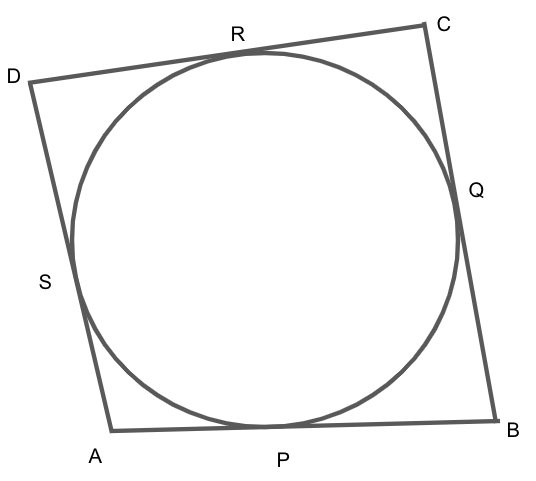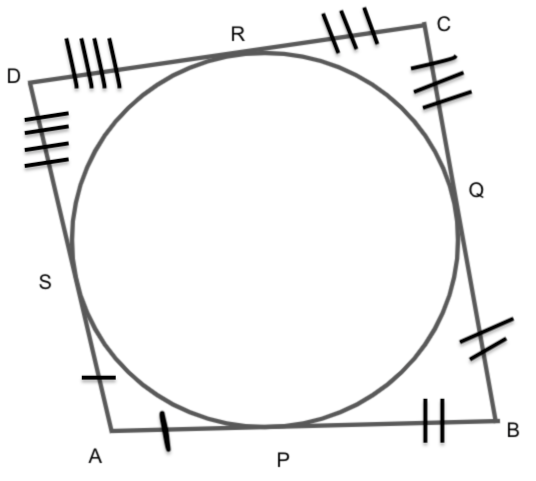
A quadrilateral ABCD is drawn to circumscribe a circle (see Figure). Prove that \[{\text{AB}} + {\text{CD}} = {\text{AD}} + {\text{BC}}\].


Answer
572.7k+ views
Hint: First, we will use the tangents drawn from an exterior point to a circle are equal in length and then add the obtained equations. Then we will use the \[AP + BP = AB\], \[BQ + CQ = BC\], \[CR + DR = CD\] and \[AS + DS = AD\] to simplify this expression.
Complete step by step answer:
We are given that a quadrilateral ABCD is drawn to circumscribe a circle.
We know that tangents drawn from an exterior point to a circle are equal in length, so we have
\[ \Rightarrow AP = AS{\text{ ......eq.(1)}}\]
\[ \Rightarrow BP = BQ{\text{ ......eq.(2)}}\]
\[ \Rightarrow CR = CQ{\text{ ......eq.(3)}}\]
\[ \Rightarrow DR = DS{\text{ ......eq.(4)}}\]

Adding the equations (1), (2), (3) and (4), we get
\[ \Rightarrow AP + BP + CR + DR = AS + BQ + CQ + DS\]
Rewriting the above equation, we get
\[ \Rightarrow \left( {AP + BP} \right) + \left( {CR + DR} \right) = \left( {AS + DS} \right) + \left( {BQ + CQ} \right){\text{ .......eq.(5)}}\]
Since we also know that AB is a line segments and when any point P cuts this line segments, then \[AP + BP = AB\].
From the same procedure, we get
\[BQ + CQ = BC\]
\[CR + DR = CD\]
\[AS + DS = AD\]
Using these sums from the given diagram in the equation (5), we get
\[ \Rightarrow AB + CD = AD + BC\]
Hence, proved.
Note: In this question, we know that circumscribes a circle is to draw on the outside of just touching the corner points but never crossing. Here a quadrilateral is circumscribed around a circle. Students must crack the point of using that tangents drawn from an exterior point to a circle are equal in length. If we are able to crack this point, then the proof is very simple.
Complete step by step answer:
We are given that a quadrilateral ABCD is drawn to circumscribe a circle.
We know that tangents drawn from an exterior point to a circle are equal in length, so we have
\[ \Rightarrow AP = AS{\text{ ......eq.(1)}}\]
\[ \Rightarrow BP = BQ{\text{ ......eq.(2)}}\]
\[ \Rightarrow CR = CQ{\text{ ......eq.(3)}}\]
\[ \Rightarrow DR = DS{\text{ ......eq.(4)}}\]

Adding the equations (1), (2), (3) and (4), we get
\[ \Rightarrow AP + BP + CR + DR = AS + BQ + CQ + DS\]
Rewriting the above equation, we get
\[ \Rightarrow \left( {AP + BP} \right) + \left( {CR + DR} \right) = \left( {AS + DS} \right) + \left( {BQ + CQ} \right){\text{ .......eq.(5)}}\]
Since we also know that AB is a line segments and when any point P cuts this line segments, then \[AP + BP = AB\].
From the same procedure, we get
\[BQ + CQ = BC\]
\[CR + DR = CD\]
\[AS + DS = AD\]
Using these sums from the given diagram in the equation (5), we get
\[ \Rightarrow AB + CD = AD + BC\]
Hence, proved.
Note: In this question, we know that circumscribes a circle is to draw on the outside of just touching the corner points but never crossing. Here a quadrilateral is circumscribed around a circle. Students must crack the point of using that tangents drawn from an exterior point to a circle are equal in length. If we are able to crack this point, then the proof is very simple.
Recently Updated Pages
Master Class 9 Social Science: Engaging Questions & Answers for Success

Master Class 9 Science: Engaging Questions & Answers for Success

Master Class 9 English: Engaging Questions & Answers for Success

Master Class 9 Maths: Engaging Questions & Answers for Success

Master Class 9 General Knowledge: Engaging Questions & Answers for Success

Class 9 Question and Answer - Your Ultimate Solutions Guide

Trending doubts
What is the Full Form of ISI and RAW

Distinguish between Conventional and nonconventional class 9 social science CBSE

What were the main changes brought about by the Bolsheviks class 9 social science CBSE

Differentiate between the Western and the Eastern class 9 social science CBSE

Differentiate between parenchyma collenchyma and sclerenchyma class 9 biology CBSE

Give 5 examples of refraction of light in daily life




